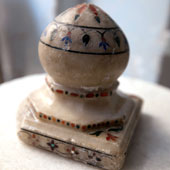Design Resource
Jaipur Stone Carving
The Skillful Crafts in Stone
by
Prof. Bibhudutta Baral,Anisha Crasto and Anushree Kumar
Jaipur is the main center for stone carving, especially for marble inlay work. The process of making stone sculptures or products can be categorized into following steps:
1. Marking
2. Cutting
3. Finishing
4. Cladding
5. Inlay
6. Polishing
1. Marking:
After purchasing a fine quality marble from the quarries, it is brought to the workplace/workshop and cut into desired size/s. To make the figure, a vertical line is drawn along the axis and then a two dimensional outline of the proposed design is drawn on the rough boulder, using a marker, a scale, right angle and compass wherever required. This is a rough hand drawn sketch in order to get an idea of the proportions and locations. During the process of cutting by stone-cutting machines water is supplied constantly so that the dust settles down.
2. Cutting:
Once the marking and outline is carved, the artisan with the help of hammer, chisel and drills extracts/bring-out the final figure by removing the unwanted material. Initially flat big chisels are used to scrap off the stone and get a rough shape of the desired figure. After that again a second level of sketching is done to mark the detailing. The process of making outline goes on as the craftsman goes along carving. Small fine chisel and drills are used for chiseling and drilling to give fine detailing and final shape to the object. The process of carving starts by giving shape to the body and then other parts like face, fingers and nails. Further minute details are carved out after completing the whole sculpture. If some piece of stone breaks while carving it is stuck with using araldite. While scraping, the stone dust get collected on the object and then it is cleaned either by brush or with the help of a blower. The dust from Makrana marble is less harmful to health as compared to the one from Alwar since it is less fine. A little precaution in eating habits helps in preventing the impurities to harm. Artisans eat jagery with ghee which helps in removing off the dust inhaled.
3. Finishing:
After carving out the whole figure sandpaper of 80, 120, 00 numbers are used to smoothen the rough parts of the statue. A mixture of Geru and water is applied on the marble sculpture, basically to define the regions on which finishing is pending. Finally the finishing is done using buffing machine.
4. Cladding:
Further, the product if necessary goes through the process of cladding. Artisans use different materials to achieve the desired result depending on the demand. Initially gold and silver cladding was done on the idols but now with the increase in the rates of gold and silver artisans have shifted to low cost options like painting, using a combination of acrylic colors and oil paints. Cladding is done by pasting very fine foils (Varak) of silver and gold on the places to be highlighted like jewelry and borders of the cloth, with the help of chemicals.
5. Inlay:
The process of inlay is also carried where ever required. Craftsmen inlay finely cut precious and semi-precious stones in products, with high dexterity. These stones are cut at home by the women in the family and sometimes by the men.
6. Polishing:
In the end, the polishing is done depending on the nature of the product. The whole process of carving is conducted with immense care as a slightest crack can cause the idol useless for worship. An average idol of four feet can take around 20 – 30 days to complete. The processes are mainly conducted by the men, while the women are rarely involved in the finishing part.
















